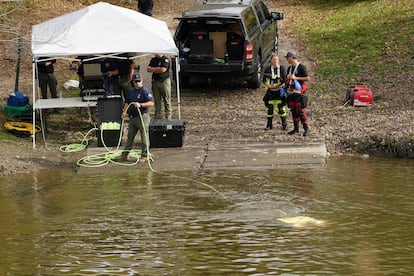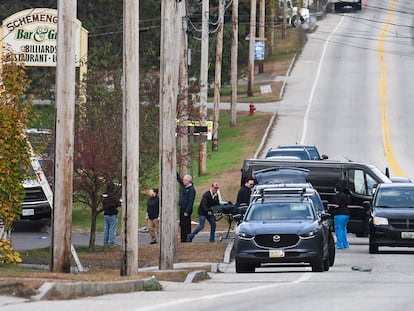The Maine mass shooting: a massacre with little precedent
Authorities had been focusing their search on Androscoggin River as the hypothesis that Robert Card is dead gained traction. He had not been seen since he killed 18 people in a bowling alley and a restaurant


This Friday morning, Blair was “minding his own business” in the lush woods on the banks of the Androscoggin River near the sleepy town of Lisbon, Maine, when he heard “something that sounded like a gunshot.” A short time later, from inside his car, he recounted the episode before shakily noting that he is a “gun owner,” as if to lend credence to his impression. He ran to take shelter inside a metal structure. He did not need to call the police.
The police already knew, as demonstrated by the helicopters that relentlessly fly over the area surrounding the place where they found the white SUV that military reservist Robert Card used on Wednesday night to carry out a massacre with a semi-automatic rifle at a bowling alley and a restaurant in neighboring Lewiston; the two places are separated by 3.7 miles (6 kilometers). Card killed 18 people and wounded 13 others. The identities were made public on Friday: almost all were residents of this town of about 40,000 inhabitants, the second-largest city in the sparsely populated northeastern state of Maine. This Friday afternoon, almost 48 hours later, they still had not found Card.
Lewiston, Lisbon and several other towns in this rural fishing and hunting area were still waiting for hundreds of local, county, state and federal agents to “hunt him down,” as the authorities put it. They were looking for him on land, as well as underwater and from the air. It was not clear that Card was alive, but if he were, the authorities constantly repeated, he is “armed and very dangerous”. The fact that the suspect was on the run makes this an unusual mass shooting.
Police SUVs and several combat vans were quickly deployed to search the area where Blair got the scare of his life, but they failed to find the killer. Ryan McGee, Lisbon’s police chief, later deemed the deployment unsuccessful. “We are pursuing dozens of leads, we will be moving our efforts elsewhere,” he told reporters.
A couple of miles away, frogmen were taking to the water in a meander of the Androscoggin River, which at this point in October is flowing in splendid fashion. During the morning press conference at Lewiston City Hall, Mike Sauschuck of the County Department of Public Safety already noted that the plan is for divers to comb those waters, with the assistance of small planes and helicopters, looking for “possible bodies.”
Sauschuck, who has become the official spokesman for the tragedy, appeared before a panel with maps of the three investigation hot spots: the aforementioned meander, the bowling alley area and the restaurant. He asked for patience from his neighbors and those anxious for the return of normalcy to the latter two locations. “We will not stop considering them ‘crime scenes’ until we have investigated the last shell casing of ammunition cartridges.” Card employed a military-style assault rifle with a scope, a weapon noted for its ability to fire hundreds of rounds in a matter of seconds.
The farewell note
The official did not give much more information, nor did he want to discuss one of the main hypotheses: that Card has been dead for hours, and that the “manhunt” is actually a search for a corpse. After all, Sauschuck confirmed, Card left his son a farewell note, the contents of which have not yet been made public; however, CNN reported that in the note, Card promised that he would not be “found alive.” Of course, in that case, it would make no sense that the authorities have ordered residents not to leave their homes and to stay there or in their cars with the doors locked.

Susan Rowland, who lives near where Card abandoned his SUV and spent that sleepless night with her daughters (because “a helicopter kept shining its spotlight on the backyard”), had another theory. She believed that the suspect’s military training and “the fact that he knows these woods very well” allowed him to escape “far away.” On the doorstep of her home this Friday, Rowland added that “if [Card] was able to kill all those people and get outside the perimeter, I don’t think he’s still around, frankly.”
The tremendous uncertainty in this case has disrupted the usual ritual that occurs every time there is a mass shooting in the United States; so far this year, there have been 567 of them, and the Lewiston shooting was the deadliest. First, a random town emerges from anonymity and becomes synonymous with terror. Then come the condolences, the “thoughts and prayers,” the sterile debate over gun control, the Republicans’ defense of the Second Amendment and the revelations and clues that emerge from the killer’s digital footprint about his motivations. The murderer usually meets one of three fates: he commits suicide, is killed by officers or is arrested at the scene.
The lockdown has also prevented the victims’ families (who are speaking to the media via Zoom) from organizing vigils and starting the collective mourning process in order to move on insofar as possible. Seven people (six men and one woman) died in the bowling alley, and eight men died in the restaurant. Three succumbed to their injuries in the hospital that night. According to the Lewiston hospital’s chief medical officer, the victims ranged from 14 to 76 years of age. The authorities had declined to release any names until Friday afternoon, although some had leaked to the media. The dead include a father and son, a sign language interpreter known for his work for local politicians, the restaurant manager and a bowling instructor. It appears that the suspect frequented both places.
Not only did the fact that Card was still on the run have the residents of this part of Maine —which has a low population density and outdoor lifestyle and is one of the easiest places to buy a gun in the country— on edge, but it has also brought back some past traumas. The experience of walking the streets of Lewiston and Bowdoin, resembles a trip back in time to the spring of 2020, during the first weeks of the pandemic. 15.5 miles (25 kilometers) away from the murder scenes, Bowdoin is the location of the suspect’s last residence. On Thursday night, another false alarm led to the belief that Card was barricaded in one of the houses in the village.
Shauschuck himself acknowledged that it is unclear how long this exceptional situation —with schools, stores and restaurants closed— can continue. This Friday, life timidly returned to some of those places, but they’re still predominantly empty. But until further notice, Halloween celebrations next Tuesday night have been suspended.
Sign up for our weekly newsletter to get more English-language news coverage from EL PAÍS USA Edition
Tu suscripción se está usando en otro dispositivo
¿Quieres añadir otro usuario a tu suscripción?
Si continúas leyendo en este dispositivo, no se podrá leer en el otro.
FlechaTu suscripción se está usando en otro dispositivo y solo puedes acceder a EL PAÍS desde un dispositivo a la vez.
Si quieres compartir tu cuenta, cambia tu suscripción a la modalidad Premium, así podrás añadir otro usuario. Cada uno accederá con su propia cuenta de email, lo que os permitirá personalizar vuestra experiencia en EL PAÍS.
¿Tienes una suscripción de empresa? Accede aquí para contratar más cuentas.
En el caso de no saber quién está usando tu cuenta, te recomendamos cambiar tu contraseña aquí.
Si decides continuar compartiendo tu cuenta, este mensaje se mostrará en tu dispositivo y en el de la otra persona que está usando tu cuenta de forma indefinida, afectando a tu experiencia de lectura. Puedes consultar aquí los términos y condiciones de la suscripción digital.
More information
Archived In
Últimas noticias
There is as much life left to discover on planet Earth as that which is already known
Dozens presumed dead, around 100 injured in fire at Swiss Alps bar during New Year’s celebration
Is porn for women different from conventional porn? We spoke to those who make it
Cartagena de Indias is sinking: What can the city do to mitigate it?
Most viewed
- David King, chemist: ‘There are scientists studying how to cool the planet; nobody should stop these experiments from happening’
- Reinhard Genzel, Nobel laureate in physics: ‘One-minute videos will never give you the truth’
- Oona Chaplin: ‘I told James Cameron that I was living in a treehouse and starting a permaculture project with a friend’
- Sinaloa Cartel war is taking its toll on Los Chapitos
- The Interoceanic Train, the Mexican alternative to the Panama Canal










































